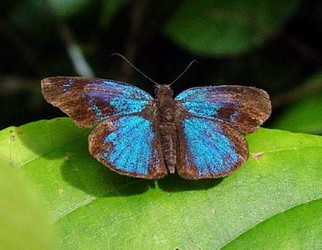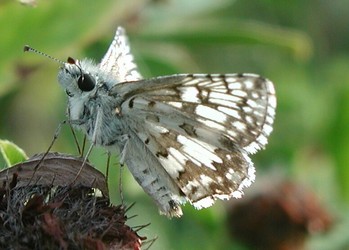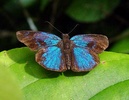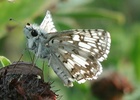Pyrgini
Andrew V. Z. Brower and Andrew Warren


This tree diagram shows the relationships between several groups of organisms.
The root of the current tree connects the organisms featured in this tree to their containing group and the rest of the Tree of Life. The basal branching point in the tree represents the ancestor of the other groups in the tree. This ancestor diversified over time into several descendent subgroups, which are represented as internal nodes and terminal taxa to the right.

You can click on the root to travel down the Tree of Life all the way to the root of all Life, and you can click on the names of descendent subgroups to travel up the Tree of Life all the way to individual species.
For more information on ToL tree formatting, please see Interpreting the Tree or Classification. To learn more about phylogenetic trees, please visit our Phylogenetic Biology pages.
close boxDiscussion of Phylogenetic Relationships
The hypothesis of relationships is based on the combined analysis of Warren et al. (2009). Taxa not included in the data matrix are tentatively situated based on shared morphological features discussed in the text.References
Warren, A. D., Ogawa, J. R. & Brower, A. V. Z. 2008 Phylogenetic relationships of subfamilies and circumscription of tribes in the family Hesperiidae (Lepidoptera: Hesperiodea). Cladistics 24, 642-676.
Warren, A. D., Ogawa, J. R. & Brower, A. V. Z. 2009 Revised classification of the family Hesperiidae (Lepidoptera: Hesperioidea) based on combined molecular and morphological data. Systematic Entomology 34, 467-523.
Title Illustrations

| Scientific Name | Paches loxus |
|---|---|
| Location | Bartola, Nicaragua |
| Specimen Condition | Live Specimen |
| Identified By | Kim Garwood |
| Life Cycle Stage | adult |
| Source | Brilliant Blue-skipper |
| Source Collection | Neotropical Butterflies |
| Copyright | © 2003 Kim Garwood |
| Scientific Name | Pyrgus communis |
|---|---|
| Location | New Brunswick, New Jersey, USA |
| Specimen Condition | Live Specimen |
| Source | Common Checkered Skipper, P8230149crop |
| Source Collection | Flickr |
| Image Use |
 This media file is licensed under the Creative Commons Attribution-NonCommercial License - Version 2.0. This media file is licensed under the Creative Commons Attribution-NonCommercial License - Version 2.0.
|
| Copyright | © 2005 Anita Gould |
About This Page
Andrew V. Z. Brower

Middle Tennessee State University, Murfreesboro, Tennessee, USA
Andrew Warren

University of Florida, Gainesville, Florida, USA
Correspondence regarding this page should be directed to Andrew V. Z. Brower at
abrower@mtsu.edu
and Andrew Warren at
hesperioidea@yahoo.com
Page copyright © 2010 Andrew V. Z. Brower and Andrew Warren
 Page: Tree of Life
Pyrgini .
Authored by
Andrew V. Z. Brower and Andrew Warren.
The TEXT of this page is licensed under the
Creative Commons Attribution License - Version 3.0. Note that images and other media
featured on this page are each governed by their own license, and they may or may not be available
for reuse. Click on an image or a media link to access the media data window, which provides the
relevant licensing information. For the general terms and conditions of ToL material reuse and
redistribution, please see the Tree of Life Copyright
Policies.
Page: Tree of Life
Pyrgini .
Authored by
Andrew V. Z. Brower and Andrew Warren.
The TEXT of this page is licensed under the
Creative Commons Attribution License - Version 3.0. Note that images and other media
featured on this page are each governed by their own license, and they may or may not be available
for reuse. Click on an image or a media link to access the media data window, which provides the
relevant licensing information. For the general terms and conditions of ToL material reuse and
redistribution, please see the Tree of Life Copyright
Policies.
- First online 04 March 2007
- Content changed 09 February 2010
Citing this page:
Brower, Andrew V. Z. and Andrew Warren. 2010. Pyrgini . Version 09 February 2010 (under construction). http://tolweb.org/Pyrgini/95263/2010.02.09 in The Tree of Life Web Project, http://tolweb.org/









 Go to quick links
Go to quick search
Go to navigation for this section of the ToL site
Go to detailed links for the ToL site
Go to quick links
Go to quick search
Go to navigation for this section of the ToL site
Go to detailed links for the ToL site